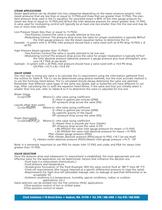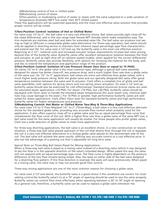 Website:
Clark
Website:
Clark
Catalog excerpts

www.clarksol.com CLARK SOLUTIONS Motor Actuated Valve Application Bail Valves, Globe Valves & Butterfly Valves INTRODUCTION The control valve is one of the most important items in a flu-idic system. If greater attention were paid to the proper siz-ing and application of control valves there would be fewer flow control problems. A valve that is undersized can result in insufficient flow at design conditions. An oversized valve is subject to instability as it attempts to control flow over a very small portion of its overall flow range. In effect, an oversized valve will have a much greater change in flow for the same change in signal as a properly sized valve. FLOW COEFFICIENT (CV) Guide The single most important piece of information needed to select a control valve is the valve sizing coefficient, Cv. Cv is defined as the flow rate in U.S.gallons of water (at 60°F) that will pass through the valve in one minute with a differential pressure across the valve of 1 PSI. A valve's Cv is unique to the size, angle of open-ing and manufacturer's style. The information to consider in determining the Cv includes: Variable Water Steam Chemicals Line Size size (inches) size (inches) size (inches) Flow Rate of Application GPM LBS/Hr or BTUH GPM Pressure Drop (DP)of the Coil or Application PSID PSID PSID Temperature of Fluid °F °F °F Chemical Type %Glycol (if any) Any Additives? Specify Type Additive Concentration NA NA % When these variables are known, the Cv required for the application can be determined using the formulas on the following pages of this bulletin. Regardless of the Cv, the valve size should not exceed the line size. For modulating applications, it is typically one or two sizes smaller than line size. CONTROL VALVE PRESSURE DROP In most instances, the only variable when calculating the Cv required of the valve is the pressure drop (DP) across the valve. The pressure drop across a valve is always measured with the valve fully open. In HVAC applications the heat exchange coil has typically been selected (or already exists) before the valve is cho-sen, therefore the GPM and pressure drop of the coil should be known. For optimal control, the pressure drop across the control valve should be equal to, or slightly greater than, the pressure drop of the coil and its fittings. This will ensure that the valve will control the flow through the coil through its entire range of travel. When controlling flow for a non-coil application, the same principle applies as indicated above for coil applications. Whatever the valve is directly controlling should be viewed as a system with a specific opening at the valve. The pressure upstream and downstream of the system determine the amount of flow through the system. Therefore, the ideal pressure drop across the control valve should be equal to, or greater than, the pressure drop of the system that is being controlled. WATER APPLICATIONS Two-Position Control -Ball,globe or butterfly valves can be used for this application. -The pressure drop across the valve should be low (usually less than 2 PSI)in its open position. -Valves for this purpose are typically selected at line size to minimize installation cost and pressure drop. In some applications, ball and butterfly valves can be used one size smaller than line size without dropping enough pressure to affect system performance. Modulating Control -The pressure drop across a two-way valve should be equal to,or slightly greater than,the pressure drop of the coil and its fittings. On a three-way valve,the pressure drop is based on the drop between the common port of the valve and the port which you are trying to control (with the port fully open). A typical coil pressure drop for HVAC applications is usually 3 PSI or less. This is the reason why a 3-5 PSI pressure drop across the valve has been used as a rule of thumb. Clark Solutions ͕ 10 Brent Drive Hudson, MA 01749 Օ Tel. 978 / 568 3400 Fax 978 / 568 0060
Open the catalog to page 1
STEAM APPLICATIONS Steam applications can be divided into two catgories depending on the steam pressure prsent: inlet steam pressures that are less than or equal to 15 PSIG,and those that are greater than 15 PSIG. The stan驭dard pressure drop used in the Cv equation for saturated steam is 80% ofthe inlet gauge pressure for steam less than or equal to 15 PSIG,and 42%of the inlet absolute pressure for steam greater than 15 PSIG. A valve used for modulating control will typically be at least one size smaller than the line size and may be two or more sizes smaller. Low Pressure Steam (less than...
Open the catalog to page 2
3)Modulating control of hot or chilled water 4)Modulating control of steam. 5)Two-position or modulating control of water or steam with the valve subjected to a wide variation of temprature (Example:180°F hot water then 45°F chilled water) These five applications will be examined separately and the most cost effective valve solution that provides proper control will be noted. 1)Two-Position Control: Isolation of Hot or Chilled Water For valve sizes 1/2"to 2", the ball valve is a very cost effective choice. Ball valves provide tight close-off for the rated differential, and in this size...
Open the catalog to page 3
minimum required Cv for the application exceeds the published flow rate of the butterfly valve with the dise at 20° open. If the minimum Cv required is less than the flow rate published for a 20° open position, a smaller ball or globe valve would have to be used in conjunction with the butterfly valve in order to provide good modulation throughout the complete flow range required of the coil. Example: Many large air handling units have minimum heating and cooling loads that exceed the flow rate of a properly sized butterfly valve at a 20° disc open position. In this application, a butterfly...
Open the catalog to page 4All Clark catalogs and technical brochures
-
Type 525
2 Pages
-
Type 520
5 Pages
-
Mounting Bracket
1 Pages
-
9QX Series
2 Pages
-
15000 series
1 Pages
-
BOXER
2 Pages
-
CS-810 Anemometer
1 Pages
-
Tubing for Peristaltic Pumps
1 Pages
-
RVL Series Vortex Flowmeters
3 Pages
-
Clark Sonic Ultrasonic Products
35 Pages






































